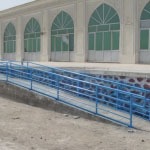Blog
Posted on May 5, 2011
What do the Zambian economy and a volcano eruption in the Democratic Republic of Congo have in common?
 Apparently nothing. However at Global Washington there is a regular combination of cultures and information sharing taking place where people, creativity, and cross-cutting ideas can come together and make the most unlikely connections. On Thursday, April, 28, 2011, Global Washington hosted Mr. Alfred Chioza is the Deputy Ambassador of Zambia in Washington D.C and Maisha Soul, a musical group from the Democratic Republic of Congo.
Apparently nothing. However at Global Washington there is a regular combination of cultures and information sharing taking place where people, creativity, and cross-cutting ideas can come together and make the most unlikely connections. On Thursday, April, 28, 2011, Global Washington hosted Mr. Alfred Chioza is the Deputy Ambassador of Zambia in Washington D.C and Maisha Soul, a musical group from the Democratic Republic of Congo.
The Zambian government’s efforts and results in creating attractive economic investments frameworks, as well as the country’s successes in economic development were mentioned by the speaker. The audience was invited to invest in agriculture, water resources, raw materials extractions, mining, tourism, health and education. Many participants at the event mentioned that they visited Zambia before and were already working in these areas or are planning to in the future.
 Maisha Soul is a band from the Democratic Republic of whose name means “soul of life”. They sang a number of songs in a mix of Swahili, English, and French. The message of the music written and performed by the four young brothers is a call for peace, promotion of brotherhood, equality, human rights, and freedom. The group was formed in 2002 after the volcanic eruption in Goma, when many people from Congo, including the performers, were in refugee camps. By that time they became a voice of hope in the middle of despair their country has struggled with for decades. The group was sponsored by HEALAfrica, a member organization of Global Washington.
Maisha Soul is a band from the Democratic Republic of whose name means “soul of life”. They sang a number of songs in a mix of Swahili, English, and French. The message of the music written and performed by the four young brothers is a call for peace, promotion of brotherhood, equality, human rights, and freedom. The group was formed in 2002 after the volcanic eruption in Goma, when many people from Congo, including the performers, were in refugee camps. By that time they became a voice of hope in the middle of despair their country has struggled with for decades. The group was sponsored by HEALAfrica, a member organization of Global Washington.
Global Washington’s mission to convene, advocate, and strengthen the international development sector here in the state, with an emphasis on the sectors of Global Health, Global Education, Environmental Sustainability, and Poverty Alleviation. As numerous international visitors come to Seattle to meet with businesses, policy makers, and educational institutions, Global Washington supports its members in organizing events like this to make the visitors accessible to the community of NGO’s, foundations, and individuals dedicated to all aspects of global development.
Liuba Ceban
Liuba.ceban@gmail.com
Posted on April 29, 2011
Over 750 people packed into Town Hall on Apr. 26th to hear journalist Tom Paulson grill four experts in global development. The goal was to discuss everything from “can charity create change” to “what does global health really mean” as said by Paulson. Panellists included Christopher Elias, the president and CEO of PATH; William Foege, a Senior medical advisor for the Bill & Melinda Gates Foundation; Wendy Johnson, Director for Health Alliance International; and Joseph Whinney, founder and CEO of Theo Chocolate.
As Paulson pointed out, Seattle is not going to save the world singlehandedly, but as he said “it is a hub of a region that has become do-gooder central.” In addition to this Seattle has become known for global health and is a city that provides opportunity for collaboration within this sector. Many Global Washington members were present at the event, which was fitting since the topics discussed revolved around re-examining global development.
The presence of Theo Chocolate in a discussion primarily about global health is evidence that there are powerful intersections both between the different sectors of global development and also between development work and the business world. As Paulson and the panellists emphasized during the discussion, you cannot discuss health without discussing poverty as the two are integrally connected. These points of intersection are central to Global Washington’s work as we bring together diverse players in development to facilitate greater innovation and collaboration. We hope that discussions like this one continue shed light on how we can effectively utilize the enthusiasm and resources in Washington to create sustainable global change.
Some of the responses to the questions were particularly relevant to Global Washington members are seen below.
Paulson: So what is Global Health?
“The world is divided into things that are broken and things that are fixed; global health is fixing things that are broken,” said Foege. The conversation later broadened to include the other panellists. “There has been a shift in perspective from ‘global health is someone else’s problem’, to ‘this is a problem that we all deal with’” said Elias. He said that this change came from three things: first, that trade and travel shrank the world; second, that there was a need to address inequalities; and third, that we have moved into understanding systems.
“Technology almost always plays a role, but almost never in isolation” said Elias. He expanded on this statement saying that to have an effect on global health, we need technology with behaviour change. Wendy Johnson, in a truly academic approach, brought up the theory behind these two techniques, explaining the concept of the “magic bullet” and “social justice.” “We like to ignore the tension” between these two methods she said, giving the example of malaria. While Johnson was more critical of our progress in moving towards the social justice approach (she was not convinced that it had happened yet), she did seem optimistic that Seattle organizations were in support of this transformation. At one point, she even quoted Elias in a former lecture where he said “you can’t perform a c-section with a cell phone,” thereby showing the agreement across the industry that behaviour change is as important as technology. Though there was not much controversy between the panellists over the questions Paulson posed, the discussion did strike a sensitive chord in the hearts of the audience as it turned to our relationship with poverty.
Paulson: Why are we so comfortable with poverty?
“We have to tolerate poverty because we all benefit from it,” responded Foege. He explained that everything in our lives comes at a cheaper cost as a direct result of poverty. Johnson said that we must remember our bias in development discussions as coming from a position of privilege. She brought up the point that Seattle is one of the whitest cities in the country as evidence of this privilege. “Until we find the right leaders, poverty will continue to be a problem because we are all so invested in it,” summed up Foege.
Paulson: Isn’t the cheapest option always going to win out?
Not necessarily. According to Whinney, “the idea of social responsibility is an integrated approach,” he said. He gave the example of the BBC documentary that came out ten years ago depicting the abysmal conditions for those working on coco farms. Initially this got large chocolate companies on board with paying farmers more he explained, but: “the needle hasn’t moved.” The needle he was referring to is a measurement of the change of salary that people are working in. “The idea of CSR has to move the needle and there must be transparency,” he said.
Later, Paulson brought up difficulty in raising awareness while also addressing the problems that a development organization may be having in achieving their goals. Elias gave the example of the Global Fund, which had some corruption issues with their TB fund a few years ago. While this corruption became news, “the story that did not get told was that the Global Fund’s increased accountability measures was what discovered the issue. To me this was a story of success,” Elias said.
Paulson: Why are so many young people getting involved in development and what would you say to them?
Simply put by Whinney answer to the first question was: “we all want to do something with our lives.” Elias explained that there are more jobs now then there were when he came through the system but that “the demand outstrips the supply.” He said that what is missing for an applicant now is that first experience. People need time to go abroad, volunteer and work with programs directly, but that “students are carrying too much debt” to do so. In regards to paid opportunities, Elias said that there is a difficulty in finding funds for paid internships.” He also mentioned that PATH gets hundreds of inquiries about these positions, which are not available, which made the future for graduates look slightly bleak.
Later, questions expanded to include the audience, whom asked several questions about our right to work on global health when our own healthcare is lacking. Johnson gave a great quote by Lila Watson, which said: “if you have come to help me you are wasting your time. But if you have come because your liberation is bound up with mine then let us work together.” An audience that would question their own perspective, in a city that shows such collaboration between sectors is proof that this is the approach we are hoping to follow.
Posted on April 28, 2011
Clear Path Launches Large-Scale Ramp Project in Afghanistan
When more than 800,000 Afghans are severely disabled, it’s easy to see why there’s a drastic need for schools, hospitals, government buildings and places of worship to be made accessible to them.
But people with disabilities in Afghanistan have suffered from a nearly universal lack of access to these and other important buildings and facilities. The Afghanistan Central Office of Statistics has estimated that 98 percent of all buildings cannot be entered by wheelchair.
This past year, Clear Path International launched a pilot project to alter this situation by constructing high-quality ramps at key locations throughout the country applying best practices established in the industry. Clear Path is a nonprofit organization that assists victims of landmines and other explosives, and others disabled or displaced by armed conflict in Southeast Asia and Afghanistan.
Not only are the projects performing a critical service for this vulnerable segment of Afghanistan’s population, they also are helping to establish good will between the United States and Afghan leaders at a time when that relationship has been severely stressed. CPI programs in Afghanistan are funded by the U.S. Department of State Weapons Removal and Abatement (WRA).
“We’ve had two different reports that the Ulema (Council of Mullahs and Imams in Afghanistan) has specifically mentioned the work of CPI at the Eid Gah Mosque, as well as commented positively in general on the role of Americans bringing accessibility changes at this very high-profile religious site,” said CPI Program Manager Matthew Rodieck. “One of the leaders of the Ulema, a double-amputee martyr and former Mujahedin commander, was especially complimentary.”
Eid Gah Mosque in Kabul is one of the highest profile mosques in Afghanistan and is where VIPs regularly worship and hold funeral prayers of martyrs. CPI through its Afghan partner organization, Accessibility Organization for Afghan Disabled (AOAD), built three ramps complete with handrails. In Kabul, CPI and AOAD also constructed three ramps at the Antoni Infectious Disease Hospital, an important referral site for tertiary care and the only facility of its kind in the country.
In Kapisa Province, north of Kabul, Afghan Amputee Bicyclists for Rehabilitation and Recreation (AABRAR) developed and implemented access ramps at several diverse sites. These included the main mosque of the capital city, which became the only physically accessible mosque in the entire province, the Ministry of Information and Culture, and the Ministry of Education. Several public schools throughout the rural community were also ramp sites in the AABRAR project, each selected based on feedback from local authorities about their priorities.
In Balkh Province, in the north of Afghanistan, Afghan Landmine Survivor Organization (ALSO) constructed access ramps at several educational settings across Mazar-i Sharif, the main city of Balkh. The sites selected included co-educational elementary schools, boys’ high schools, girls’ high schools, and the Balkh University making it one of the few institutions of higher learning in the entire country with accessible buildings.
Going forward, CPI hopes to build nearly 600 ramps at 350 sites throughout Afghanistan. The $660,000 project funded by WRA will involve the same three partner organizations. A key component of the ramp project is to raise awareness of the rights of people with disabilities, said Rodieck. “Awareness is quite low; there’s not much sensitivity.”
That awareness campaign also will make its way into the classroom at Kabul Technical University’s Engineering School where CPI hopes it will result in some practical solutions. “We want to engage the entire faculty on physical accessibility design,” Rodieck said. “We want to advocate on a more institutional level that the curriculum become more realistic.”
For more information about this project, contact Matthew Rocieck at matthew@cpi.org.

 Apparently nothing. However at Global Washington there is a regular combination of cultures and information sharing taking place where people, creativity, and cross-cutting ideas can come together and make the most unlikely connections. On Thursday, April, 28, 2011, Global Washington hosted Mr. Alfred Chioza is the Deputy Ambassador of Zambia in Washington D.C and Maisha Soul, a musical group from the Democratic Republic of Congo.
Apparently nothing. However at Global Washington there is a regular combination of cultures and information sharing taking place where people, creativity, and cross-cutting ideas can come together and make the most unlikely connections. On Thursday, April, 28, 2011, Global Washington hosted Mr. Alfred Chioza is the Deputy Ambassador of Zambia in Washington D.C and Maisha Soul, a musical group from the Democratic Republic of Congo. Maisha Soul is a band from the Democratic Republic of whose name means “soul of life”. They sang a number of songs in a mix of Swahili, English, and French. The message of the music written and performed by the four young brothers is a call for peace, promotion of brotherhood, equality, human rights, and freedom. The group was formed in 2002 after the volcanic eruption in Goma, when many people from Congo, including the performers, were in refugee camps. By that time they became a voice of hope in the middle of despair their country has struggled with for decades. The group was sponsored by HEALAfrica, a member organization of Global Washington.
Maisha Soul is a band from the Democratic Republic of whose name means “soul of life”. They sang a number of songs in a mix of Swahili, English, and French. The message of the music written and performed by the four young brothers is a call for peace, promotion of brotherhood, equality, human rights, and freedom. The group was formed in 2002 after the volcanic eruption in Goma, when many people from Congo, including the performers, were in refugee camps. By that time they became a voice of hope in the middle of despair their country has struggled with for decades. The group was sponsored by HEALAfrica, a member organization of Global Washington.